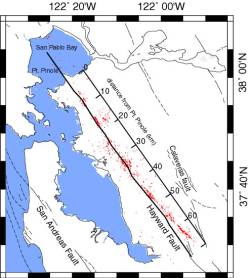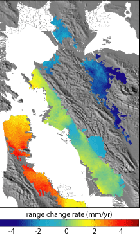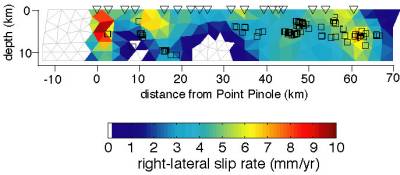The Aseismic Slip-Rate on the Hayward Fault, California
 The Hayward fault, located in the San Francisco Bay Area, is a major strand of the San Andreas fault system accommodating nearly 25% of the deformation across the plate boundary. The fault exhibits a diversity of slip behaviors including large coseismic rupture, frequent micro-seismicity, and aseismic creep. Surface creep is observed along the entire length of the fault in the range of 3-9 mm/yr and the rates appear to be consistent over the past several decades. The geologic slip-rate on the fault is estimated at ~9 mm/yr. The difference between the geologic and contemporary creep rates suggests that a slip deficit exists and that the accumulatingelastic strain will presumably be released in a future earthquake. The seismic hazard posed by the fault, the diversity of creep behavior, and the availability of complimentary data sets make the Hayward fault an ideal natural laboratory for study.
The Hayward fault, located in the San Francisco Bay Area, is a major strand of the San Andreas fault system accommodating nearly 25% of the deformation across the plate boundary. The fault exhibits a diversity of slip behaviors including large coseismic rupture, frequent micro-seismicity, and aseismic creep. Surface creep is observed along the entire length of the fault in the range of 3-9 mm/yr and the rates appear to be consistent over the past several decades. The geologic slip-rate on the fault is estimated at ~9 mm/yr. The difference between the geologic and contemporary creep rates suggests that a slip deficit exists and that the accumulatingelastic strain will presumably be released in a future earthquake. The seismic hazard posed by the fault, the diversity of creep behavior, and the availability of complimentary data sets make the Hayward fault an ideal natural laboratory for study.
 We analyze a diverse data set to image the distribution of aseismic slip-rate across the fault to address the potential for future, large earthquakes. A least-squares inversion is performed using data from Interferometric Synthetic Aperture Radar (InSAR), the Global Positioning
System (GPS), slip-rate estimates from characteristic
repeating earthquake (CRE) sequences, and surface slip-rate
observations. The result of the inversion provides constraints on the amount of strain accumulating on the fault plane both along-strike and with depth.
We analyze a diverse data set to image the distribution of aseismic slip-rate across the fault to address the potential for future, large earthquakes. A least-squares inversion is performed using data from Interferometric Synthetic Aperture Radar (InSAR), the Global Positioning
System (GPS), slip-rate estimates from characteristic
repeating earthquake (CRE) sequences, and surface slip-rate
observations. The result of the inversion provides constraints on the amount of strain accumulating on the fault plane both along-strike and with depth.
The mapped surface trace and the inferred fault plane at depth imaged by the precise relocation of micorseismicity suggest that the Hayward fault is a non-planar structure [Waldhauser and Ellsworth, 2002]. Therefore we represent the sub-vertical fault surface using triangular elements and calculate the elastic Green's functions.
A weighted inversion is performed using a bounded variable least squares algorithm. Preliminary results find a heterogeneous slip-rate distribution. The distribution of aseismic slip-rate on the Hayward fault suggests spatially variable fault behavior consistent with the findings of previous studies [Lienkaemper et al., 1991; Simpson et al., 2001]. A rate of <1 mm/yr is
found below and to the north of the San Leandro seismic cluster (km 33). This feature is consistent regardless of the relative weights of the data sets or the degree of smoothing. A slip-rates <1 mm/yr likely represents regions where the fault is not slipping either because the fault is locked or because slip is restrained.
Locked sections may represent the nucleation site or the rupture area of future large earthquakes.
The inversion places >8 mm/yr on the northern portion of the fault plane beneath Pt. Pinole (km 0). The slip-rate patch extends from the top to the bottom of the model and is flanked to the south by a <2 mm/yr slip-rate patch at kilometer 10. Fault elements to the north of Point Pinole as fixed at zero in the inversion because of the lack of data north of this point. The model consistently under-predicts the offset in range-change across the fault at Pinole by as much as 1 mm/yr which can be explained by an unmodelled small dip-slip component.
Additional details can be found in Schmidt et al. (2005) and Schmidt and Burgmann (2008)
References
Lienkaemper, J. J., Borchardt, G., and M. Lisowski, Historic creep rate and potential for seismic slip along the Hayward fault, California, J. Geophys. Res., 96, 18261- 18283, 1991.
Simpson, R. W., Lienkaemper, J. J., and J. S. Galehouse, Variations in creep rate along the Hayward Fault, California, interpreted as changes in depth of creep, Geophys. Res. Lett., 28, 2269-2272, 2001.
Waldhauser, F., and W. L. Ellsworth, Fault structure and mechanics of the Hayward fault, California, from double- difference earthquake locations, J. Geophys. Res., 107, 10.1029/2000JB000084, 2002.
Wyss, M., Locked and creeping patches along the Hayward fault, California, Geophys. Res. Lett., 28, 3537- 3540, 2001.

